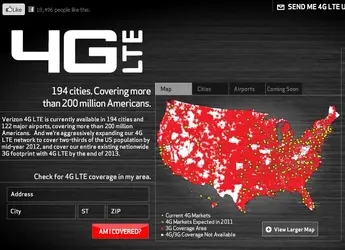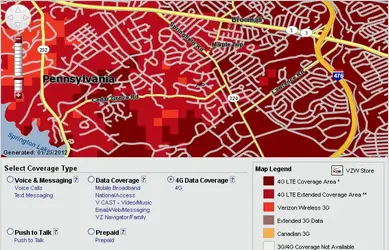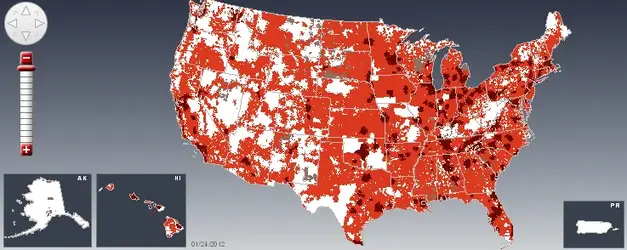DroidForums.net | Android Forum & News
You are using an out of date browser. It may not display this or other websites correctly.
You should upgrade or use an alternative browser.
You should upgrade or use an alternative browser.
Razr 4G sucks!!!
- Thread starter ascreen06
- Start date
Does anyone know if 4G technology is more greatly impacted by physical structures?
I live in an older house with cement floors, and in the basement I can barely keep a 4G signal and 3G tends to be ok. This is beyond my technical prowess, but I know 4G is strong in my area, because as mentioned above, I get a very strong 4G signal outside the basement. Perhaps this is the cause for some of the issues people are having?
Actually Verizon 4G LTE uses the 700mhz band whereas earlier Verizon data technologies used either 800mhz or 1,900mhz and with the wider bandwidth LTE both transmits farther and propagates better than either Verizon 3G or cellular voice assuming the same tower distance and power of transmission. This should result in better coverage and farther penetration into structures. Unfortunately there are not nearly the number or concentration of towers which have 4G transmitters as there are those with 3G so it is easy to conclude (incorrectly) that 3G is either more powerful or that it penetrates buildings better than 4G.
All too often the people who experience 4G problems or fringe reception are in an area of coverage known as 4G LTE Extended Coverage rather than 4G LTE Standard coverage. This means they are getting the coverage from long-range LTE antennas which extend the coverage for line-of-sight communication but with a weaker signal as compared to 3G service in their specific areas. Thus the 3G signal may actually be stronger in basements than 4G signals. As 4G LTE sites are added into markets, this should improve LTE service and signal penetration to eventually better results than 3G.
Line-of-sight or LTE Extended Coverage flies out across the surrounding areas farther distances but tends to be at higher altitudes, so lower lying areas and below ground levels will get passed over. Think of a donut versus a pancake (or squashed flat donut), where the donut is the shape of signal patterns in areas of standard 4G (and 3G) coverage versus the pancake shape in 4G Extended coverage areas. The pancake is thin so it will only provide signal near ground level and just above but will extend further out in all directions yet the donut is fat so it will reach both higher and lower but not as far out from center.
Sent from my DROID RAZR using DroidForums
The Razr has a great radio. People just have to understand that 4G is not everywhere. My Razr picks up 4G in my house in Phoenix just fine. I have had non Motorola phones that don't even get a 3G signal inside my home. So just remember when buying a 4G that it won't work all the time.
LoneWolfArcher
Silver Member
I'm thinking its not so much the 4g in the phone but the actual tower. I used to have problems too then one day no more problems finding a 4g signal. And yes i had problems after the update, but its good now.
I think this is right. My wife and I were very happy with our 4G service at home. About 2 weeks ago I noticed that I was connected to 3G at home and that's all I have had since. Might call Verizon, but I think it is our nearby tower that is causing the issue.
Love my 4G I live in Cincinnati but have also had to travel to Dallas. Consistently got downloads speeds of 10 and higher peaked once near 20. Drained the heck out of my battery though. If your 4G sucks it's probably not your phone but coverage in your areanews flash, 4g isn't available and stable in all areas.
View attachment 46364
if you are not in the darker areas that are shown on the map, then you wont have 4g coverage.
news flash, 4g isn't available and stable in all areas.
View attachment 46364
if you are not in the darker areas that are shown on the map, then you wont have 4g coverage.
Although the map linked to above is generally correct, it's somewhat misleading. You'd be better going to 4G LTE Network | Verizon Wireless. This will bring you to a screen that looks like this;
 .
.You enter the actual physical address where you wish to determine coverage (lower left side of the page) and press the red "Am I Covered" button. Once the answer shows up, click on the red "View Coverage Map" button. This will give you a very accurate representation of where coverage lies for you and what type. You would probably benefit from zooming out a couple clicks on the negative (-) sign at the top left of the map. Anywhere that the color is DARK RED shows strong coverage in the 4G LTE areas. This is the fat Donut areas I was talking about. Anywhere that the color is RED, will be areas addressed by the 4G LTE Extended Coverage antennas. This is the Pancake areas I was talking about.
Here's a representation of my area and home (my house is the red pin in the middle - unfortunately). If you click on the PIC, you'll see it closer. In my case, the DARK RED 4G LTE (Donut) coverage area is to my East and South by only a few blocks. As I travel home daily I run up the road that's diagonal from the bottom right to top middle (Route 320). As I ride on that road, the 4G coverage is SUPERB since it's covered by the 4G LTE (Donut) Coverage antennas. I stream music in FLAC (Lossless Compression) in my car from my home PC at about 1MB/sec with no hiccups. Once I turn left off of that road and head into my small development, the coverage begins to fade. While driving through my development I am traveling DOWN HILL into a small low-lying area with a creek. As I get close to my street or just as I turn onto my street, the 4G signal disappears and the 3G takes over. Even though I am clearly in the RED 4G LTE Extended (Pancake) Coverage Area, my house and the others in my immediate neighborhood sit too low (near the creek level) to capture the signal from the 4G LTE Extended Coverage antennas, so the signal literally flies right over my house. I can stand on the roof and raise the phone above my head and get 4G (and yes, I've done it), but in the house, in the driveway and yard, on the street 40 feet below, no 4G.

Also, think of the coverage representations as LAYERS, where the 3G layer in LIGHT RED is essentially everywhere on the map above underneath the other coverages, then the MIDDLE RED is laid on top and finally the DARK RED is on top again, so where there's good 4G LTE coverage (DARK RED), you'll likely not see the 3G signal on your phone at all because it will opt for the strong 4G instead. That doesn't mean there's no 3G there and if you turned off the LTE radio, you'd get 3G. If you are in an area where the 4G LTE Extended Coverage is, the liklihood is you'll still get 4G, but it depends on how high (or low) of an altitude you are at - like my home. If you're in a low-lying area, you might still only get 3G. And finally if you're in an area where the 4G LTE or LTE Extended Coverage is non-existent, then you'll get 3G all the time.
I am waiting for Verizon to add a Donut 4G Cell Site nearer to my home, or for a manufacturer to sell a 4G LTE signal booster that will work with Verizon. Right now, only 3G signal boosters are available that work with Verizon. If I could get a 4G LTE signal booster, I'd only have to place the antenna on my chimney and run a line into my home, place the booster on an interior wall and I'd have 4G. But whether I have 4G in the home or not is MOOT, since I have a WIFI router. So not having 4G in the house isn't really a concern. For the most part, once I leave my immediate housing community (and I normally travel generally in the East - Southeast direction (towards and into Philadelphia), I have 4G all the time.
Try this yourself and you may start to realize that it's NOT THE PHONE in most cases.
LoneWolfArcher
Silver Member
I think this is right. My wife and I were very happy with our 4G service at home. About 2 weeks ago I noticed that I was connected to 3G at home and that's all I have had since. Might call Verizon, but I think it is our nearby tower that is causing the issue.
So I called Verizon. Tech Support created an engineering ticket. They are going to have the issue investigated since I live in an area that should get 4G, and the 4G service was incredible until a couple of weeks ago. She said it could take 2-14 days to get the results, especially if they have to check out towers, but that she will follow up with me as soon as she is told something.
Pretty cool.
Although the map linked to above is generally correct, it's somewhat misleading. You'd be better going to 4G LTE Network | Verizon Wireless. This will bring you to a screen that looks like this;
View attachment 46368.
not misleading. its the exact same map as yours, just all the green dots are replaced with dark red blobs
not misleading. its the exact same map as yours, just all the green dots are replaced with dark red blobs
That was not a shot at you. I apologize if you took it that way since it was not intended to imply YOU were misleading. Also, I agree that it's the same map as the first one in my post (except for the Green dots), but it's not the map itself I was pointing to, it's the site where you can get accurate information for your local area as represented by the lower map showing the immediate area near my home. I could have drilled down even further but it then puts a pin right on my house and you can see street names and my exact location. Now I like you guys and gals, but I don't need some possibly disturbed individual deciding to physically hunt me down for something I posted that was misinterpreted on these forums. I am sure you understand.
What I meant by THE MAP being misleading was that it is a national coverage map and could easily be misinterpreted by someone if they are in the general geographic region where the map indicates coverage since it's such a broad stroke view. By going to the page I referred to (where the map you mention with the "green dots" sits) and THEN entering your address (as I clearly indicated above), it gives you a far more accurate close-up representation of how spotty or continuous actual coverage is in your immediate area.
In other words the scale of the map on the pic you inserted is far too coarse to be illustrative of real and usable coverage at ground level, and since it's a pic and not a link to the actual map where scale can be changed via the zoom on the left, it doesn't give an accurate representation of whether I will have coverage 3 blocks away from my home or at my home, only whether I'd have coverage SOMEWHERE in the state.
Also, terrain has a dramatic affect on coverage so someone who lives in an area where the ground is relatively flat for long distances (like in the immediate Denver city limits area or here in Philadelphia) will get good coverage over greater distances from only one 4G LTE Extended Coverage antenna (assuming no major structures such as buildings), whereas someone who lives in a more hilly area such as I do in the suburbs of Philadelphia (or in your case as you go pretty much any direction out from the city in Denver) will suffer dropouts in low-lying areas and those terrains require multiple cell sites with focused and overlapping coverage and at various points both in high altitudes and low altitudes to truly saturate the area with consistent data connection.
This explains why the map in your post shows some areas in the central states that are VAST and have many hundreds of miles showing only 3G Coverage and then select relatively smaller areas of the dark red showing 4G LTE Coverage. What it doesn't show you is that within those areas which are indicated as 4G Coverage on the national map, there are literally thousands of pockets of the regular 4G LTE Coverage (concentrated areas of many smaller cell sites with short reaching antennas), and then there's large areas both surrounding and within those pockets that are only receiving 4G LTE Extended Coverage (less concentrated larger cell sites with long reaching antennas), and then there's even areas within those dark red areas where it's only 3G Coverage.
Again, the comment was meant to try and give people a realistic picture of what their own coverage in a very small geographic radius will look like and respond like, rather than saying "there's 4G LTE in Pennsylvania" and assuming if I live in Pennsylvania I'll have 4G LTE all the time as the pic you provided could be misinterpreted as illustrating.
Sent from my DROID RAZR using DroidForums
DIESEL-USMC
Member
I just got the razr 3days ago after having the incredible. I have 4-5 bars in my basement man cave when the incredible had the dreaded x no service. I'm very happy.
Sent from my DROID RAZR using DroidForums
Sent from my DROID RAZR using DroidForums
DIESEL-USMC
Member
But I do not get 4g here but a mile up the road I do.
Sent from my DROID RAZR using DroidForums
Sent from my DROID RAZR using DroidForums
I'm happy with both 3G/4G on my Razr even with the occasional 4G data drops. I use 3G at work and when I'm home I'll either switch to 4G/WIFI whichever I prefer. To say 4G sucks there are a myriad of reason why it could suck and most of it could be Verizon's fault or you just live in an area where 4G doesn't exist yet or you could be sitting on a huge iron ore mine. Only way to figure it out is by calling Verizon and have them troubleshoot your area.
Sent from my rooted and Safe Strapped Motor DROID RAZR
Sent from my rooted and Safe Strapped Motor DROID RAZR
But I do not get 4g here but a mile up the road I do.
Sent from my DROID RAZR using DroidForums
Try the Verizon service map site above and see the coverage for your home.
Sent from my DROID RAZR using DroidForums
Similar threads
- Replies
- 1
- Views
- 2K

